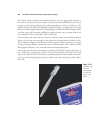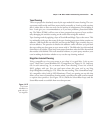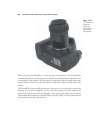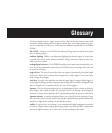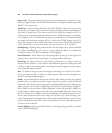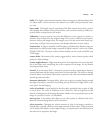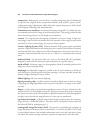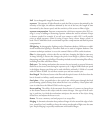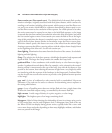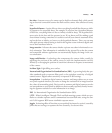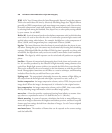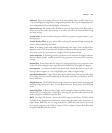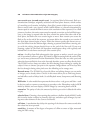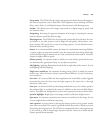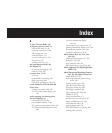front-curtain sync (first-curtain sync) The default kind of electronic flash synchro-
nization technique, originally associated with focal plane shutters, which consists of a
traveling set of curtains, including a front curtain, which opens to reveal the film or sen-
sor, and a rear curtain, which follows at a distance determined by shutter speed to con-
ceal the film or sensor at the conclusion of the exposure. For a flash picture to be taken,
the entire sensor must be exposed at one time to the brief flash exposure, so the image
is exposed after the front curtain has reached the other side of the focal plane, but before
the rear curtain begins to move. Front-curtain sync causes the flash to fire at the begin-
ning of this period when the shutter is completely open, in the instant that the first cur-
tain of the focal plane shutter finishes its movement across the film or sensor plane.
With slow shutter speeds, this feature can create a blur effect from the ambient light,
showing as patterns that follow a moving subject with the subject shown sharply frozen
at the beginning of the blur trail. See also rear-curtain sync.
front lighting Illumination that comes from the direction of the camera. See also back-
lighting and side lighting.
f/stop The relative size of the lens aperture, which helps determine both exposure and
depth-of-field. The larger the f/stop number, the smaller the f/stop itself.
graduated filter A lens attachment with variable density or color from one edge to
another. A graduated neutral-density filter, for example, can be oriented so the neutral-
density portion is concentrated at the top of the lens’s view with the less dense or clear
portion at the bottom, thus reducing the amount of light from a very bright sky while
not interfering with the exposure of the landscape in the foreground. Graduated filters
can also be split into several color sections to provide a color gradient between portions
of the image.
gray card A piece of cardboard or other material with a standardized 18-percent
reflectance. Gray cards can be used as a reference for determining correct exposure or
for setting white balance.
group A way of bundling more than one wireless flash unit into a single cluster that
all share the same flash output setting, as controlled by the master flash unit.
high contrast A wide range of density in a print, negative, or other image.
highlights The brightest parts of an image containing detail.
histogram A kind of chart showing the relationship of tones in an image using a series
of 256 vertical bars, one for each brightness level. A histogram chart, such as the one
the Nikon D7000 can display during picture review, typically looks like a curve with
one or more slopes and peaks, depending on how many highlight, midtone, and shadow
tones are present in the image.
David Busch’s Nikon D7000 Guide to Digital SLR Photography494



